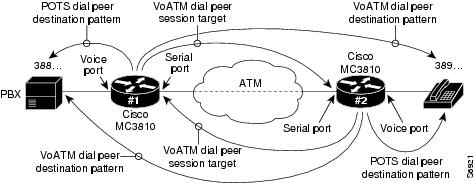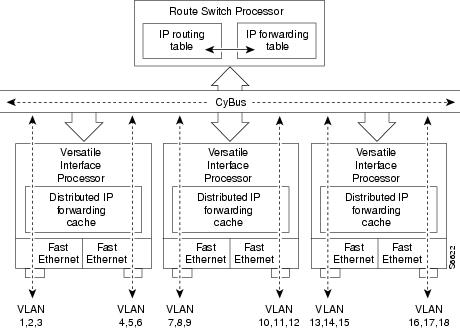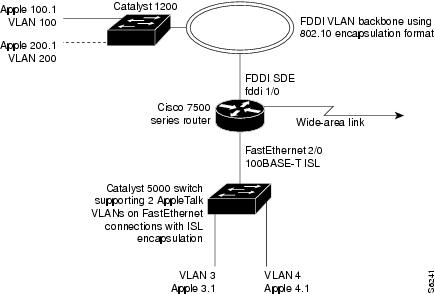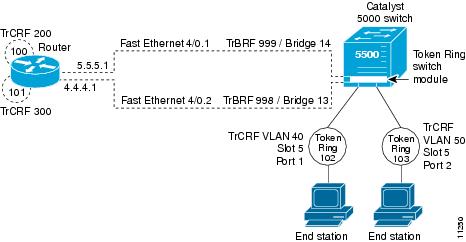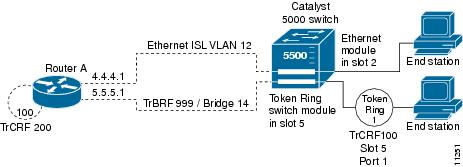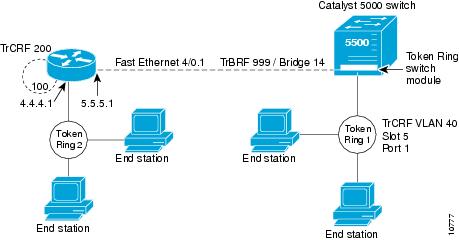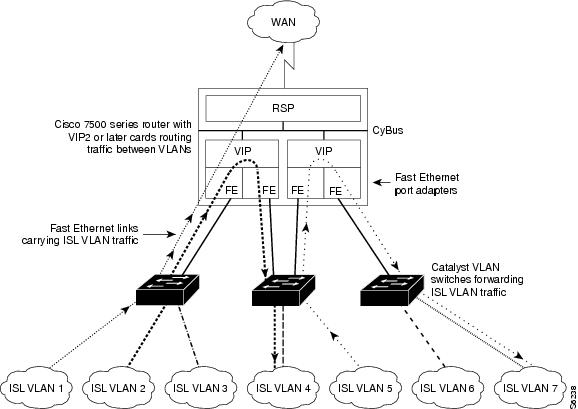 Feedback Feedback
|
Table Of Contents
Configuring Routing Between VLANs with Inter-Switch Link Encapsulation
ISL Encapsulation Configuration Task List
Configuring AppleTalk Routing over ISL
Defining the VLAN Encapsulation Format
Configuring AppleTalk on the Subinterface
Configuring Banyan VINES Routing over ISL
Defining the VLAN Encapsulation Format
Configuring Banyan VINES on the Subinterface
Configuring DECnet Routing over ISL
Defining the VLAN Encapsulation Format
Configuring DECnet on the Subinterface
Configuring the Hot Standby Router Protocol over ISL
Defining the Encapsulation Format
Configuring IP Routing over TRISL
Defining the VLAN Encapsulation Format
Assigning IP Address to Network Interface
Configuring IPX Routing on 802.10 VLANs over ISL
Defining the VLAN Encapsulation Format
Configuring NetWare on the Subinterface
Configuring IPX Routing over TRISL
Defining the VLAN Encapsulation Format
Configuring NetWare on the Subinterface
Configuring VIP Distributed Switching over ISL
Enabling VIP Distributed Switching
Configuring ISL Encapsulation on the Subinterface
Configuring XNS Routing over ISL
Defining the VLAN Encapsulation Format
Configuring XNS on the Subinterface
Configuring CLNS Routing over ISL
Defining the VLAN Encapsulation Format
Configuring CLNS on the Subinterface
Configuring IS-IS Routing over ISL
Defining the VLAN Encapsulation Format
Configuring IS-IS on the Subinterface
Monitoring and Maintaining VLAN Subinterfaces
ISL Encapsulation Configuration Examples
AppleTalk Routing over ISL Configuration Examples
Banyan VINES Routing over ISL Configuration Example
DECnet Routing over ISL Configuration Example
HSRP over ISL Configuration Example
IP Routing with RIF Between TrBRF VLANs Example
IP Routing Between a TRISL VLAN and an Ethernet ISL VLAN Example
IPX Routing over ISL Configuration Example
IPX Routing on FDDI Interfaces with SDE Example
Routing with RIF Between a TRISL VLAN and a Token Ring Interface Example
VIP Distributed Switching over ISL Configuration Example
XNS Routing over ISL Configuration Example
CLNS Routing over ISL Configuration Example
IS-IS Routing over ISL Configuration Example
Configuring Routing Between VLANs with Inter-Switch Link Encapsulation
This chapter describes the Inter-Switch Link (ISL) protocol and provides guidelines for configuring ISL and Token Ring ISL (TRISL) features.
For a complete description of the commands in this chapter, refer to the the Cisco IOS Switching Services Command Reference. To locate documentation of other commands that appear in this chapter, use the command reference master index or search online.
To identify the hardware platform or software image information associated with a feature, use the Feature Navigator on Cisco.com to search for information about the feature or refer to the software release notes for a specific release. For more information, see the section "Identifying Supported Platforms" in the chapter "Using Cisco IOS Software."
Overview of the ISL Protocol
ISL is a Cisco protocol for interconnecting multiple switches and maintaining VLAN information as traffic goes between switches. ISL provides VLAN capabilities while maintaining full wire speed performance on Fast Ethernet links in full- or half-duplex mode. ISL operates in a point-to-point environment and will support up to 1000 VLANs. You can define virtually as many logical networks as are necessary for your environment.
This chapter describes how to configure routing between VLANs using ISL encapsulation.
Frame Tagging in ISL
With ISL, an Ethernet frame is encapsulated with a header that transports VLAN IDs between switches and routers. A 26-byte header that contains a 10-bit VLAN ID is prepended to the Ethernet frame.
A VLAN ID is added to the frame only when the frame is destined for a nonlocal network. Figure 78 shows VLAN packets traversing the shared backbone. Each VLAN packet carries the VLAN ID within the packet header.
Figure 78 VLAN Packets Traversing the Shared Backbone
ISL Encapsulation Configuration Task List
You can configure routing between any number of VLANs in your network. This section documents the configuration tasks for each protocol supported with ISL encapsulation. The basic process is the same, regardless of the protocol being routed. It involves the following tasks:
•
Enabling the protocol on the router
•
Enabling the protocol on the interface
•
Defining the encapsulation format as ISL or TRISL
•
Customizing the protocol according to the requirements for your environment
To configure routing between any number of VLANs in your network, perform the tasks described in the following sections particular to your network:
•
Configuring AppleTalk Routing over ISL
•
Configuring Banyan VINES Routing over ISL
•
Configuring DECnet Routing over ISL
•
Configuring the Hot Standby Router Protocol over ISL
•
Configuring IP Routing over TRISL
•
Configuring IPX Routing over TRISL
•
Configuring VIP Distributed Switching over ISL
•
Configuring XNS Routing over ISL
•
Configuring CLNS Routing over ISL
•
Configuring IS-IS Routing over ISL
•
Monitoring and Maintaining VLAN Subinterfaces
Refer to the "ISL Encapsulation Configuration Examples" section at the end of this chapter for sample configurations.
Configuring AppleTalk Routing over ISL
AppleTalk can be routed over VLAN subinterfaces using the ISL and IEEE 802.10 VLAN encapsulation protocols. The AppleTalk Routing over ISL and IEEE 802.10 Virtual LANs feature provides full-feature Cisco IOS software AppleTalk support on a per-VLAN basis, allowing standard AppleTalk capabilities to be configured on VLANs.
To route AppleTalk over ISL or IEEE 802.10 between VLANs, you need to customize the subinterface to create the environment in which it will be used. Perform the tasks described in the following sections in the order in which they appear:
•
Defining the VLAN Encapsulation Format
•
Configuring AppleTalk on the Subinterface
Enabling AppleTalk Routing
To enable AppleTalk routing on either ISL or 802.10 interfaces, use the following command in global configuration mode:
Router(config)# appletalk routing [eigrp router-number]
Enables AppleTalk routing globally.
Defining the VLAN Encapsulation Format
To define the VLAN encapsulation format as either ISL or 802.10, use the following commands in interface configuration mode:
Configuring AppleTalk on the Subinterface
After you enable AppleTalk globally and define the encapsulation format, you need to enable it on the subinterface by specifying the cable range and naming the AppleTalk zone for each interface. To enable the AppleTalk protocol on the subinterface, use the following commands in interface configuration mode:
Configuring Banyan VINES Routing over ISL
Banyan VINES can be routed over VLAN subinterfaces using the ISL encapsulation protocol. The Banyan VINES Routing over ISL Virtual LANs feature provides full-feature Cisco IOS software Banyan VINES support on a per-VLAN basis, allowing standard Banyan VINES capabilities to be configured on VLANs.
To route Banyan VINES over ISL between VLANs, you need to configure ISL encapsulation on the subinterface. Perform the tasks described in the following sections in the order in which they appear:
•
Enabling Banyan VINES Routing
•
Defining the VLAN Encapsulation Format
•
Configuring Banyan VINES on the Subinterface
Enabling Banyan VINES Routing
To begin the VINES routing configuration, use the following command in global configuration mode:
Defining the VLAN Encapsulation Format
To define the VINES routing encapsulation format, use the following commands in interface configuration mode:
Configuring Banyan VINES on the Subinterface
After you enable Banyan VINES globally and define the encapsulation format, you need to enable VINES on the subinterface by specifying the VINES routing metric. To enable the Banyan VINES protocol on the subinterface, use the following command in interface configuration mode:
Router(config-if)# vines metric [whole [fractional]]
Enables VINES routing on an interface.
Configuring DECnet Routing over ISL
DECnet can be routed over VLAN subinterfaces using the ISL VLAN encapsulation protocols. The DECnet Routing over ISL Virtual LANs feature provides full-feature Cisco IOS software DECnet support on a per-VLAN basis, allowing standard DECnet capabilities to be configured on VLANs.
To route DECnet over ISL VLANs, you need to configure ISL encapsulation on the subinterface. Perform the tasks described in the following sections in the order in which they appear.
•
Defining the VLAN Encapsulation Format
•
Configuring DECnet on the Subinterface
Enabling DECnet Routing
To begin the DECnet routing configuration, use the following command in global configuration mode:
Router(config)# decnet [network-number] routing [decnet-address]
Enables DECnet on the router.
Defining the VLAN Encapsulation Format
To define the encapsulation format, use the following commands in interface configuration mode:
Configuring DECnet on the Subinterface
To configure DECnet routing on the subinterface, use the following command in interface configuration mode:
Configuring the Hot Standby Router Protocol over ISL
The Hot Standby Router Protocol (HSRP) provides fault tolerance and enhanced routing performance for IP networks. HSRP allows Cisco IOS routers to monitor each other's operational status and very quickly assume packet forwarding responsibility in the event the current forwarding device in the HSRP group fails or is taken down for maintenance. The standby mechanism remains transparent to the attached hosts and can be deployed on any LAN type. With multiple Hot Standby groups, routers can simultaneously provide redundant backup and perform loadsharing across different IP subnets.
Figure 79 illustrates HSRP in use with ISL providing routing between several VLANs.
Figure 79 Hot Standby Router Protocol in VLAN Configurations
A separate HSRP group is configured for each VLAN subnet so that Cisco IOS router A can be the primary and forwarding router for VLANs 10 and 20. At the same time, it acts as backup for VLANs 30 and 40. Conversely, Router B acts as the primary and forwarding router for ISL VLANs 30 and 40, as well as the secondary and backup router for distributed VLAN subnets 10 and 20.
Running HSRP over ISL allows users to configure redundancy between multiple routers that are configured as front ends for VLAN IP subnets. By configuring HSRP over ISLs, users can eliminate situations in which a single point of failure causes traffic interruptions. This feature inherently provides some improvement in overall networking resilience by providing load balancing and redundancy capabilities between subnets and VLANs.
To configure HSRP over ISLs between VLANs, you need to create the environment in which it will be used. Perform the tasks described in the following sections in the order in which they appear.
•
Defining the Encapsulation Format
Defining the Encapsulation Format
To define the encapsulation format as ISL, use the following commands in interface configuration mode:
Defining the IP Address
After you have specified the encapsulation format, to define the IP address over which HSRP will be routed, use the following command in interface configuration mode:
Router(config-if)# ip address ip-address mask [secondary]
Specifies the IP address for the subnet on which ISL will be used.
Enabling HSRP
To enable HSRP on an interface, enable the protocol, then customize it for the interface. Use the following command in interface configuration mode:
Note
For more information on HSRP, see the "Configuring IP Services" chapter in the Cisco IOS IP Configuration Guide.
To customize Hot Standby group attributes, use the following commands in interface configuration mode, as needed:
Configuring IP Routing over TRISL
The IP routing over TRISL VLANs feature extends IP routing capabilities to include support for routing IP frame types in VLAN configurations.
Enabling IP Routing
IP routing is automatically enabled in the Cisco IOS software for routers. To reenable IP routing if it has been disabled, use the following command in global configuration mode:
Once you have IP routing enabled on the router, you can customize the characteristics to suit your environment. If necessary, refer to the IP configuration chapters in the Cisco IOS IP Routing Configuration Guide for guidelines on configuring IP.
Defining the VLAN Encapsulation Format
To define the encapsulation format as TRISL, use the following commands in interface configuration mode:
The DRiP database is automatically enabled when TRISL encapsulation is configured, and at least one TrBRF is defined, and the interface is configured for SRB or for routing with RIF.
Assigning IP Address to Network Interface
An interface can have one primary IP address. To assign a primary IP address and a network mask to a network interface, use the following command in interface configuration mode:
Router(config-if)# ip address ip-address mask
Sets a primary IP address for an interface.
A mask identifies the bits that denote the network number in an IP address. When you use the mask to subnet a network, the mask is then referred to as a subnet mask.
Note
TRISL encapsulation must be specified for a subinterface before an IP address can be assigned to that subinterface.
Configuring IPX Routing on 802.10 VLANs over ISL
The IPX Encapsulation for 802.10 VLAN feature provides configurable IPX (Novell-FDDI, SAP, SNAP) encapsulation over 802.10 VLAN on router FDDI interfaces to connect the Catalyst 5000 VLAN switch. This feature extends Novell NetWare routing capabilities to include support for routing all standard IPX encapsulations for Ethernet frame types in VLAN configurations. Users with Novell NetWare environments can now configure any one of the three IPX Ethernet encapsulations to be routed using Secure Data Exchange (SDE) encapsulation across VLAN boundaries. IPX encapsulation options now supported for VLAN traffic include the following:
•
Novell-FDDI (IPX FDDI RAW to 802.10 on FDDI)
•
SAP (IEEE 802.2 SAP to 802.10 on FDDI)
•
SNAP (IEEE 802.2 SNAP to 802.10 on FDDI)
NetWare users can now configure consolidated VLAN routing over a single VLAN trunking FDDI interface. Not all IPX encapsulations are currently supported for SDE VLAN. The IPX interior encapsulation support can be achieved by messaging the IPX header before encapsulating in the SDE format. Fast switching will also support all IPX interior encapsulations on non-MCI platforms (for example non-AGS+ and non-7000). With configurable Ethernet encapsulation protocols, users have the flexibility of using VLANs regardless of their NetWare Ethernet encapsulation. Configuring Novell IPX encapsulations on a per-VLAN basis facilitates migration between versions of Netware. NetWare traffic can now be routed across VLAN boundaries with standard encapsulation options (arpa, sap, and snap) previously unavailable. Encapsulation types and corresponding framing types are described in the "Configuring Novell IPX" chapter of the Cisco IOS AppleTalk and Novell IPX Configuration Guide.
Note
Only one type of IPX encapsulation can be configured per VLAN (subinterface). The IPX encapsulation used must be the same within any particular subnet; a single encapsulation must be used by all NetWare systems that belong to the same VLAN.
To configure Cisco IOS software on a router with connected VLANs to exchange different IPX framing protocols, perform the tasks described in the following sections in the order in which they are appear:
•
Defining the VLAN Encapsulation Format
•
Configuring NetWare on the Subinterface
Enabling NetWare Routing
To enable IPX routing on SDE interfaces, use the following command in global configuration mode:
Defining the VLAN Encapsulation Format
To define the encapsulation format as SDE, use the following commands in interface configuration mode:
Configuring NetWare on the Subinterface
After you enable NetWare globally and define the VLAN encapsulation format, to enable the subinterface by specifying the NetWare network number (if necessary) and the encapsulation type, use the following command in interface configuration mode:
Router(config-if)# ipx network network encapsulation encapsulation-type
Specifies the IPX encapsulation among Novell-FDDI, SAP, or SNAP.
Configuring IPX Routing over TRISL
The IPX Routing over ISL VLANs feature extends Novell NetWare routing capabilities to include support for routing all standard IPX encapsulations for Ethernet frame types in VLAN configurations. Users with Novell NetWare environments can configure either SAP or SNAP encapsulations to be routed using the TRISL encapsulation across VLAN boundaries. The SAP (Novell Ethernet_802.2) IPX encapsulation is supported for VLAN traffic.
NetWare users can now configure consolidated VLAN routing over a single VLAN trunking interface. With configurable Ethernet encapsulation protocols, users have the flexibility of using VLANs regardless of their NetWare Ethernet encapsulation. Configuring Novell IPX encapsulations on a per-VLAN basis facilitates migration between versions of Netware. NetWare traffic can now be routed across VLAN boundaries with standard encapsulation options (sap and snap) previously unavailable. Encapsulation types and corresponding framing types are described in the "Configuring Novell IPX" chapter of the Cisco IOS AppleTalk and Novell IPX Configuration Guide.
Note
Only one type of IPX encapsulation can be configured per VLAN (subinterface). The IPX encapsulation used must be the same within any particular subnet: A single encapsulation must be used by all NetWare systems that belong to the same LANs.
To configure Cisco IOS software to exchange different IPX framing protocols on a router with connected VLANs, perform the tasks described in the following sections in the order in which they are appear:
•
Defining the VLAN Encapsulation Format
•
Configuring NetWare on the Subinterface
Enabling NetWare Routing
To enable IPX routing on TRISL interfaces, use the following command in global configuration mode:
Defining the VLAN Encapsulation Format
To define the encapsulation format as TRISL, use the following commands in interface configuration mode:
Configuring NetWare on the Subinterface
After you enable NetWare globally and define the VLAN encapsulation format, to enable the subinterface by specifying the NetWare network number (if necessary) and the encapsulation type, use the following command in interface configuration mode:
Router(config-if)# ipx network network encapsulation encapsulation-type
Specifies the IPX encapsulation.
Note
The default IPX encapsulation format for Cisco IOS routers is "novell-ether" (Novell Ethernet_802.3). If you are running Novell Netware 3.12 or 4.0, the new Novell default encapsulation format is Novell Ethernet_802.2 and you should configure the Cisco router with the IPX encapsulation format "sap."
Configuring VIP Distributed Switching over ISL
With the introduction of the VIP distributed ISL feature, ISL encapsulated IP packets can be switched on Versatile Interface Processor (VIP) controllers installed on Cisco 7500 series routers.
The second generation VIP2 provides distributed switching of IP encapsulated in ISL in VLAN configurations. Where an aggregation route performs inter-VLAN routing for multiple VLANs, traffic can be switched autonomously on-card or between cards rather than through the central Route Switch Processor (RSP). Figure 80 shows the VIP distributed architecture of the Cisco 7500 series router.
Figure 80 Cisco 7500 Distributed Architecture
This distributed architecture allows incremental capacity increases by installation of additional VIP cards. Using VIP cards for switching the majority of IP VLAN traffic in multiprotocol environments substantially increases routing performance for the other protocols because the RSP offloads IP and can then be dedicated to switching the non-IP protocols.
VIP distributed switching offloads switching of ISL VLAN IP traffic to the VIP card, removing involvement from the main CPU. Offloading ISL traffic to the VIP card substantially improves networking performance. Because you can install multiple VIP cards in a router, VLAN routing capacity is increased linearly according to the number of VIP cards installed in the router.
To configure distributed switching on the VIP, you must first configure the router for IP routing. Perform the tasks described in the following sections in the order in which they appear:
•
Enabling VIP Distributed Switching
•
Configuring ISL Encapsulation on the Subinterface
Enabling IP Routing
To enable IP routing, use the following command in global configuration mode:
Once you have IP routing enabled on the router, you can customize the characteristics to suit your environment. Refer to the IP configuration chapters in the Cisco IOS IP Routing Configuration Guide for guidelines on configuring IP.
Enabling VIP Distributed Switching
To enable VIP distributed switching, use the following commands beginning in interface configuration mode:
Configuring ISL Encapsulation on the Subinterface
To configure ISL encapsulation on the subinterface, use the following commands in interface configuration mode:
Configuring XNS Routing over ISL
XNS can be routed over VLAN subinterfaces using the ISL VLAN encapsulation protocol. The XNS Routing over ISL Virtual LANs feature provides full-feature Cisco IOS software XNS support on a per-VLAN basis, allowing standard XNS capabilities to be configured on VLANs.
To route XNS over ISL VLANs, you need to configure ISL encapsulation on the subinterface. Perform the tasks described in the following sections in the order in which they appear:
•
Defining the VLAN Encapsulation Format
•
Configuring XNS on the Subinterface
Enabling XNS Routing
To configure XNS routing, use the following command in global configuration mode:
Defining the VLAN Encapsulation Format
To define the VLAN encapsulation format, use the following commands in interface configuration mode:
Configuring XNS on the Subinterface
To enable XNS on the subinterface by specifying the XNS network number, use the following command in interface configuration mode:
Configuring CLNS Routing over ISL
CLNS can be routed over VLAN subinterfaces using the ISL VLAN encapsulation protocol. The CLNS Routing over ISL Virtual LANs feature provides full-feature Cisco IOS software CLNS support on a per-VLAN basis, allowing standard CLNS capabilities to be configured on VLANs.
To route CLNS over ISL VLANs, you need to configure ISL encapsulation on the subinterface. Perform the tasks described in the following sections in the order in which they appear:
•
Defining the VLAN Encapsulation Format
•
Configuring CLNS on the Subinterface
Enabling CLNS Routing
To configure CLNS routing, use the following command in global configuration mode:
Defining the VLAN Encapsulation Format
To define the VLAN encapsulation format, use the following commands in interface configuration mode:
Configuring CLNS on the Subinterface
To enable CLNS on the subinterface by specifying the CLNS network number, use the following command in interface configuration mode:
Configuring IS-IS Routing over ISL
IS-IS routing can be enabled over VLAN subinterfaces using the ISL VLAN encapsulation protocol. The IS-IS Routing over ISL Virtual LANs feature provides full-feature Cisco IOS software IS-IS support on a per-VLAN basis, allowing standard IS-IS capabilities to be configured on VLANs.
To enable IS-IS over ISL VLANs, you need to configure ISL encapsulation on the subinterface. Perform the tasks described in the following sections in the order in which they appear:
•
Defining the VLAN Encapsulation Format
•
Configuring IS-IS on the Subinterface
Enabling IS-IS Routing
To configure IS-IS routing, use the following command in global configuration mode:
Defining the VLAN Encapsulation Format
To define the VLAN encapsulation format, use the following commands in interface configuration mode:
Configuring IS-IS on the Subinterface
To enable IS-IS on the subinterface by specifying the IS-IS network number, use the following command in interface configuration mode:
Router(config-if)# clns router isis network [tag]
Specifies the interfaces that should be actively routing IS-IS.
Monitoring and Maintaining VLAN Subinterfaces
To indicate whether a VLAN is a native VLAN, use the following command in privileged EXEC mode:
ISL Encapsulation Configuration Examples
This section provides the following configuration examples for each of the protocols described in this chapter:
•
AppleTalk Routing over ISL Configuration Examples
•
Banyan VINES Routing over ISL Configuration Example
•
DECnet Routing over ISL Configuration Example
•
HSRP over ISL Configuration Example
•
IP Routing with RIF Between TrBRF VLANs Example
•
IP Routing Between a TRISL VLAN and an Ethernet ISL VLAN Example
•
IPX Routing over ISL Configuration Example
•
IPX Routing on FDDI Interfaces with SDE Example
•
Routing with RIF Between a TRISL VLAN and a Token Ring Interface Example
•
VIP Distributed Switching over ISL Configuration Example
•
XNS Routing over ISL Configuration Example
•
CLNS Routing over ISL Configuration Example
•
IS-IS Routing over ISL Configuration Example
AppleTalk Routing over ISL Configuration Examples
The configuration example illustrated in Figure 81 shows AppleTalk being routed between different ISL and IEEE 802.10 VLAN encapsulating subinterfaces.
Figure 81 Routing AppleTalk over VLAN Encapsulations
As shown in Figure 81, AppleTalk traffic is routed to and from switched VLAN domains 3, 4, 100, and 200 to any other AppleTalk routing interface. This example shows a sample configuration file for the Cisco 7500 series router with the commands entered to configure the network shown in Figure 81.
Cisco 7500 Router Configuration
!appletalk routinginterface Fddi 1/0.100encapsulation sde 100appletalk cable-range 100-100 100.2appletalk zone 100!interface Fddi 1/0.200encapsulation sde 200appletalk cable-range 200-200 200.2appletalk zone 200!interface FastEthernet 2/0.3encapsulation isl 3appletalk cable-range 3-3 3.2appletalk zone 3!interface FastEthernet 2/0.4encapsulation isl 4appletalk cable-range 4-4 4.2appletalk zone 4!Banyan VINES Routing over ISL Configuration Example
To configure routing of the Banyan VINES protocol over ISL trunks, you need to define ISL as the encapsulation type. This example shows Banyan VINES configured to be routed over an ISL trunk:
vines routinginterface fastethernet 0.1encapsulation isl 100vines metric 2DECnet Routing over ISL Configuration Example
To configure routing the DECnet protocol over ISL trunks, you need to define ISL as the encapsulation type. This example shows DECnet configured to be routed over an ISL trunk:
decnet routing 2.1interface fastethernet 1/0.1encapsulation isl 200decnet cost 4HSRP over ISL Configuration Example
The configuration example shown in Figure 82 shows HSRP being used on two VLAN routers sending traffic to and from ISL VLANs through a Catalyst 5000 switch. Each router forwards its own traffic and acts as a standby for the other.
Figure 82 Hot Standby Router Protocol Sample Configuration
The topology shown in Figure 82 shows a Catalyst VLAN switch supporting Fast Ethernet connections to two routers running HSRP. Both routers are configured to route HSRP over ISLs.
The standby conditions are determined by the standby commands used in the configuration. Traffic from Host 1 is forwarded through Router A. Because the priority for the group is higher, Router A is the active router for Host 1. Because the priority for the group serviced by Host 2 is higher in Router B, traffic from Host 2 is forwarded through Router B, making Router B its active router.
In the configuration shown in Figure 82, if the active router becomes unavailable, the standby router assumes active status for the additional traffic and automatically routes the traffic normally handled by the router that has become unavailable.
Host 1 Configuration
interface Ethernet 1/2ip address 10.1.1.25 255.255.255.0ip route 0.0.0.0 0.0.0.0 10.1.1.101Host 2 Configuration
interface Ethernet 1/2ip address 10.1.1.27 255.255.255.0ip route 0.0.0.0 0.0.0.0 10.1.1.102!Router A Configuration
interface FastEthernet 1/1.110encapsulation isl 110ip address 10.1.1.2 255.255.255.0standby 1 ip 10.1.1.101standby 1 preemptstandby 1 priority 105standby 2 ip 10.1.1.102standby 2 preempt!end!Router B Configuration
interface FastEthernet 1/1.110encapsulation isl 110ip address 10.1.1.3 255.255.255.0standby 1 ip 10.1.1.101standby 1 preemptstandby 2 ip 10.1.1.102standby 2 preemptstandby 2 priority 105router igrp 1!network 10.1.0.0network 10.2.0.0!VLAN Switch Configuration
set vlan 110 5/4set vlan 110 5/3set trunk 2/8 110set trunk 2/9 110IP Routing with RIF Between TrBRF VLANs Example
Figure 83 shows IP routing with RIF between two TrBRF VLANs.
Figure 83 IP Routing with RIF Between TrBRF VLANs
The following is the configuration for the router:
interface FastEthernet4/0.1ip address 10.5.5.1 255.255.255.0encapsulation tr-isl trbrf-vlan 999 bridge-num 14multiring trcrf-vlan 200 ring 100multiring all!interface FastEthernet4/0.2ip address 10.4.4.1 255.255.255.0encapsulation tr-isl trbrf-vlan 998 bridge-num 13multiring trcrf-vlan 300 ring 101multiring allThe following is the configuration for the Catalyst 5000 switch with the Token Ring switch module in slot 5. In this configuration, the Token Ring port 102 is assigned with TrCRF VLAN 40 and the Token Ring port 103 is assigned with TrCRF VLAN 50:
#vtpset vtp domain trislset vtp mode serverset vtp v2 enable#dripset set tokenring reduction enableset tokenring distrib-crf disable#vlansset vlan 999 name trbrf type trbrf bridge 0xe stp ieeeset vlan 200 name trcrf200 type trcrf parent 999 ring 0x64 mode srbset vlan 40 name trcrf40 type trcrf parent 999 ring 0x66 mode srbset vlan 998 name trbrf type trbrf bridge 0xd stp ieeeset vlan 300 name trcrf300 type trcrf parent 998 ring 0x65 mode srbset vlan 50 name trcrf50 type trcrf parent 998 ring 0x67 mode srb#add token port to trcrf 40set vlan 40 5/1#add token port to trcrf 50set vlan 50 5/2set trunk 1/2 onIP Routing Between a TRISL VLAN and an Ethernet ISL VLAN Example
Figure 84 shows IP routing between a TRISL VLAN and an Ethernet ISL VLAN.
Figure 84 IP Routing Between a TRISL VLAN and an Ethernet ISL VLAN
The following is the configuration for the router:
interface FastEthernet4/0.1ip address 10.5.5.1 255.255.255.0encapsulation tr-isl trbrf-vlan 999 bridge-num 14multiring trcrf-vlan 20 ring 100multiring all!interface FastEthernet4/0.2ip address 10.4.4.1 255.255.255.0encapsulation isl 12IPX Routing over ISL Configuration Example
Figure 85 shows IPX interior encapsulations configured over ISL encapsulation in VLAN configurations. Note that three different IPX encapsulation formats are used. VLAN 20 uses SAP encapsulation, VLAN 30 uses ARPA, and VLAN 70 uses novell-ether encapsulation. Prior to the introduction of this feature, only the default encapsulation format, "novell-ether," was available for routing IPX over ISL links in VLANs.
Figure 85 Configurable IPX Encapsulations Routed over ISL in VLAN Configurations
VLAN 20 Configuration
ipx routinginterface FastEthernet 2/0no shutdowninterface FastEthernet 2/0.20encapsulation isl 20ipx network 20 encapsulation sapVLAN 30 Configuration
ipx routinginterface FastEthernet 2/0no shutdowninterface FastEthernet 2/0.30encapsulation isl 30ipx network 30 encapsulation arpaVLAN 70 Configuration
ipx routinginterface FastEthernet 3/0no shutdowninterface Fast3/0.70encapsulation isl 70ipx network 70 encapsulation novell-etherIPX Routing on FDDI Interfaces with SDE Example
The following example enables IPX routing on FDDI interfaces 0.2 and 0.3 with SDE. On FDDI interface 0.2, the encapsulation type is SNAP. On FDDI interface 0.3, the encapsulation type is Novell's FDDI_RAW.
ipx routinginterface fddi 0.2 enc sde 2ipx network f02 encapsulation snapinterface fddi 0.3 enc sde 3ipx network f03 encapsulation novell-fddiRouting with RIF Between a TRISL VLAN and a Token Ring Interface Example
Figure 86 shows routing with RIF between a TRISL VLAN and a Token Ring interface.
Figure 86 Routing with RIF Between a TRISL VLAN and a Token Ring Interface
The following is the configuration for the router:
source-bridge ring-group 100!interface TokenRing 3/1ip address 10.4.4.1 255.255.255.0!interface FastEthernet4/0.1ip address 10.5.5.1 255.255.255.0encapsulation tr-isl trbrf 999 bridge-num 14multiring trcrf-vlan 200 ring-group 100multiring allThe following is the configuration for the Catalyst 5000 switch with the Token Ring switch module in slot 5. In this configuration, the Token Ring port 1 is assigned to the TrCRF VLAN 40:
#vtpset vtp domain trislset vtp mode serverset vtp v2 enable#dripset set tokenring reduction enableset tokenring distrib-crf disable#vlansset vlan 999 name trbrf type trbrf bridge 0xe stp ieeeset vlan 200 name trcrf200 type trcrf parent 999 ring 0x64 mode srtset vlan 40 name trcrf40 type trcrf parent 999 ring 0x1 mode srt#add token port to trcrf 40set vlan 40 5/1set trunk 1/2 onVIP Distributed Switching over ISL Configuration Example
Figure 87 shows a topology in which Catalyst VLAN switches are connected to routers forwarding traffic from a number of ISL VLANs. With the VIP distributed ISL capability in the Cisco 7500 series router, each VIP card can route ISL-encapsulated VLAN IP traffic. The inter-VLAN routing capacity is increased linearly by the packet-forwarding capability of each VIP card.
Figure 87 VIP Distributed ISL VLAN Traffic
In Figure 87, the VIP cards forward the traffic between ISL VLANs or any other routing interface. Traffic from any VLAN can be routed to any of the other VLANs, regardless of which VIP card receives the traffic.
These commands show the configuration for each of the VLANs shown in Figure 87:
interface FastEthernet1/0/0ip address 10.1.1.1 255.255.255.0ip route-cache distributedfull-duplexinterface FastEthernet1/0/0.1ip address 10.1.1.1 255.255.255.0encapsulation isl 1interface FastEthernet1/0/0.2ip address 10.1.2.1 255.255.255.0encapsulation isl 2interface FastEthernet1/0/0.3ip address 10.1.3.1 255.255.255.0encapsulation isl 3interface FastEthernet1/1/0ip route-cache distributedfull-duplexinterface FastEthernet1/1/0.1ip address 172.16.1.1 255.255.255.0encapsulation isl 4interface Fast Ethernet 2/0/0ip address 10.1.1.1 255.255.255.0ip route-cache distributedfull-duplexinterface FastEthernet2/0/0.5ip address 10.2.1.1 255.255.255.0encapsulation isl 5interface FastEthernet2/1/0ip address 10.3.1.1 255.255.255.0ip route-cache distributedfull-duplexinterface FastEthernet2/1/0.6ip address 10.4.6.1 255.255.255.0encapsulation isl 6interface FastEthernet2/1/0.7ip address 10.4.7.1 255.255.255.0encapsulation isl 7XNS Routing over ISL Configuration Example
To configure routing of the XNS protocol over ISL trunks, you need to define ISL as the encapsulation type. This example shows XNS configured to be routed over an ISL trunk:
xns routing 0123.4567.adcbinterface fastethernet 1/0.1encapsulation isl 100xns network 20CLNS Routing over ISL Configuration Example
To configure routing of the CLNS protocol over ISL trunks, you need to define ISL as the encapsulation type. This example shows CLNS configured to be routed over an ISL trunk:
clns routinginterface fastethernet 1/0.1encapsulation isl 100clns enableIS-IS Routing over ISL Configuration Example
To configure IS-IS routing over ISL trunks, you need to define ISL as the encapsulation type. This example shows IS-IS configured over an ISL trunk:
isis routing test-proc2net 49.0001.0002.aaaa.aaaa.aaaa.00interface fastethernet 2.0encapsulation isl 101clns router is-is test-proc2
